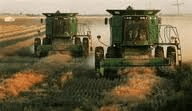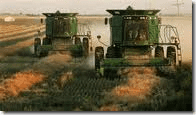DES MOINES, Iowa – The demand for canola, best known for the cooking oil it produces, continues to rise, and the industry is working to grow more of the plant in the U.S. to keep pace with increased sales.
Experts said the best hope for meeting demand is to grow a variety of canola that is planted in the fall and harvested in the spring, offering farmers in some regions a chance to make use of their land during a normally dormant period.
Most of the nation’s canola crop is a spring variety, planted in the spring and harvested in late summer or early fall. About 90 percent of U.S. canola is grown in North Dakota, but by growing more winter canola, industry officials believe canola acres in the U.S. could more than triple.
“There is no reason we couldn’t see 4 to 5 million acres planted from the Carolinas to the Great Plains,” said Dale Thorenson, assistant director of the U.S. Canola Association.
Brian Jenks, a professor at North Dakota State University, said the country needs to keep pace with the growing demand for canola, which is seen as healthier than oils containing more saturated fat.
“We grow about 1.5 million acres in the U.S. and that is not enough to satisfy demand so we have to import a lot of canola from Canada,” he said.
The U.S. used just over 3 billion pounds of canola oil in 2010, with about 2.5 billion pounds being imported from Canada, according to the National Agricultural Statistics Service.
The canola plant, recognizable for its yellow flowers, produces pods that are filled with seeds. When crushed, those seeds yield oil.
The seeds also can be used for livestock feed.
Winter canola has done well in states such as Kansas, Oklahoma and Missouri, where it is planted after another crop is harvested, said Brian Caldbeck, a crop consultant from Kentucky. That process is called double cropping.
Caldbeck said growing winter canola in areas of the Upper Midwest, such as Iowa, is possible but would be more difficult because the region primarily grows corn and soybeans, two crops that often aren’t harvested until late fall. That wouldn’t leave enough time for farmers to plant winter canola.
“If it’s not planted by the end of September it doesn’t stand a chance,” he said.
To grow winter canola, farmers in the Upper Midwest would need to rotate other crops, such as wheat and oats, with corn and soybeans. That would be a change for many farmers, who now often alternate between corn and soybeans.
“It would be impossible in the rotation as it is,” said Stefan Gailans, a graduate student at Iowa State University who is studying the viability of winter canola as an alternative crop in Iowa.
Mary Wiedenhoeft, an Iowa State University agronomist who also is studying how to grow winter canola in Iowa, said planting the crop on ground that otherwise would sit dormant after the fall harvest would not only add a source of revenue for producers but would also help to retain nutrients in the soil.
Researchers acknowledge many farmers would be reluctant to grow crops other than corn and soybeans, given the high prices the commodities are bringing now and the likelihood prices will remain strong into the future.
But Thorenson, of the national canola association, said once a canola crop is established it would bring about the same price as soybeans.
Mark Peterson, a farmer north of Joplin, Mo., said he’s been planting winter canola for four years. Because his area’s growing season for corn and soybeans is shorter than in states to the north, he has been able to rotate canola with corn, soybean and wheat.
“As far as profit goes, it’s been a little more profitable than our wheat crop,” Peterson said.
Brad Andrews, owner of Medoc Valley, Inc., a farm retail and consulting business near Joplin, Mo., said farmers in northern states should seriously look at working canola into their crop rotation.
“The market for it is there,” Andrews said. “We are still importing the majority of canola we use in this country.”
http://www.inforum.com/event/article/id/331151/group/Agriculture/


Deprecated: strpos(): Passing null to parameter #1 ($haystack) of type string is deprecated in /home/agriviek8Qv/agriviet.net/public_html/wp-includes/comment-template.php on line 2522